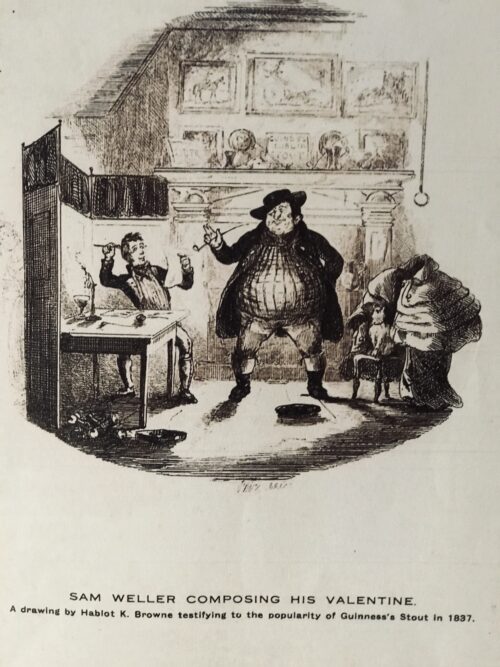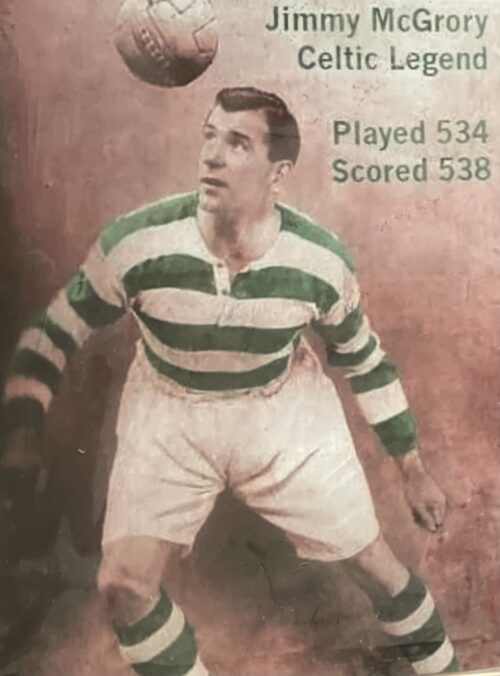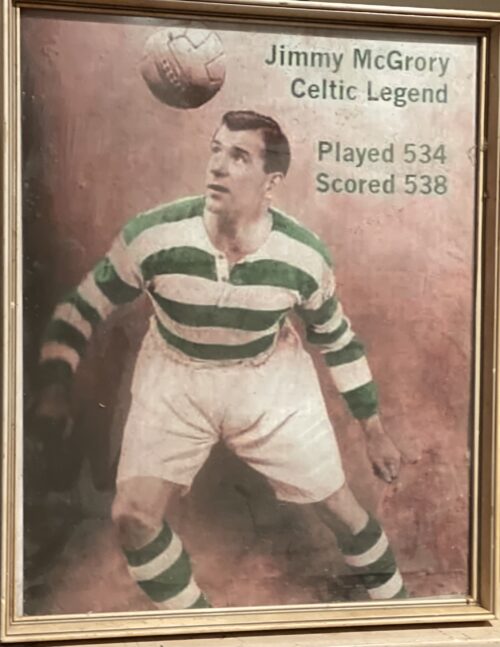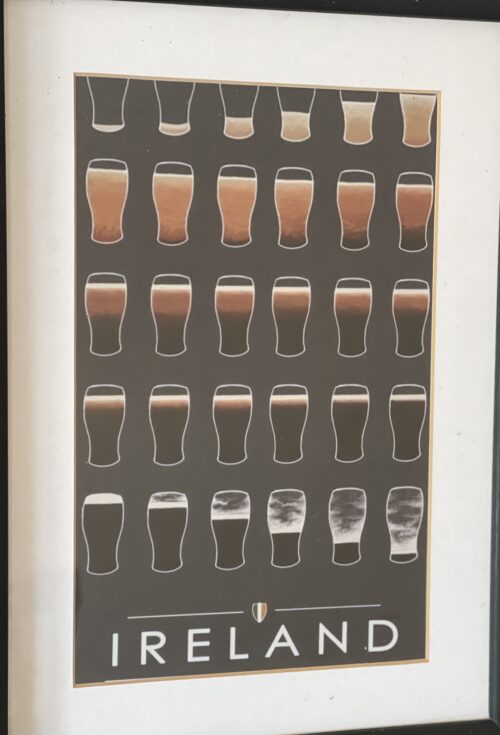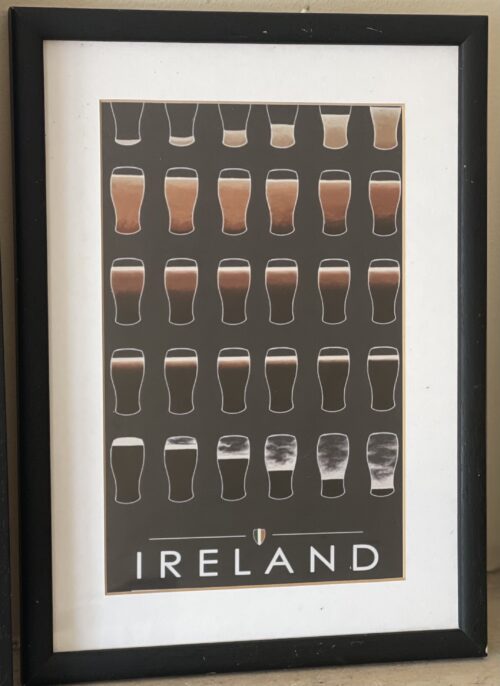Framed moment of Glasgow Celtic Great-Jimmy McGrory.
Dunfanaghy Co Donegal 40cm x 33cm
James Edward McGrory (26 April 1904 – 20 October 1982) was a Scottish International
football player, who played for
Celtic and
Clydebank as a
forward, and then went on to manage
Kilmarnock, before returning to
Celtic as manager after the end of the Second World War.
He is the all-time leading goalscorer in top-flight British football with a total of 550 goals in competitive first-team games at club and international level. McGrory is a legendary figure within Celtic's history; he is their top scorer of all time with 522 goals, and holds their record for the most goals in a season, with 57 League and Scottish Cup goals from 39 games in season 1926–27. He has also notched up a British top-flight record of 55
hat-tricks, 48 coming in League games and 7 from Scottish Cup ties. It could be argued he in fact scored 56, as he hit 8 goals in a Scottish League game against
Dunfermline in 1928, also a British top-flight record.
He was at Celtic for 15 years between 1922 and 1937, although he did spend the majority of the 1923–24 season on loan at fellow 1st Division side
Clydebank. After a spell managing
Kilmarnock from December 1937 to July 1945, he became Celtic manager, where he remained for just under 20 years, until March 1965 when he was succeeded by
Jock Stein.
Even although he was only 5 ft 6ins, he was renowned for his prowess and ability from headers. His trademark was an almost horizontal, bullet header, which he performed and scored regularly from and which earned him his nicknames, of the "Human Torpedo" and the "Mermaid".
Early life
McGrory was born at Millburn Street,
Glasgow. He was the son of Henry McGrory and Catherine Coll, both of whom were
Irish Catholic immigrants from
Ulster. Henry and Catherine had been married at St. Baithin's Church (known locally as 'the Chapel') in
St. Johnston, a village in The Laggan district in the east of
County Donegal, before emigrating to Scotland. While Catherine was from The Laggan, Henry may have been from elsewhere within County Donegal. Jimmy's elder brother was born in St. Johnston before the family left for Glasgow. They lived in Glasgow's East End on his father's wages as a gasworks labourer.
Playing career
St Roch's
McGrory began playing for
St Roch's Juniors aged 16, earning £2 a week.
In his first season of 1921–22, he helped the side win a
Double. St Roch's won the
Scottish Junior Football League and the
Scottish Junior Cup, where he scored the equalizer in a 2–1 win over
Kilwinning Rangers.
In 2013 St. Roch's renamed their ground in honour of McGrory, changing it from Provanmill Park to The James McGrory Park.
Celtic
1920s
With many clubs now scouting him, such as
Third Lanark and
Fulham,
Celtic jumped in first and approached to sign him. He signed his first full professional contract for Celtic on 10 June 1922, for £5 a week, in the pavilion at Third Lanark's
Cathkin Park.
He made his debut on 20 January 1923, in a 1–0 away defeat, also at Cathkin Park.
His first goal came two weeks later on 3 February 1923, in a 4–3 League defeat against
Kilmarnock at
Rugby Park. In total, he made three League and one Scottish Cup appearances, scoring that one goal at Rugby Park.
He was loaned out to
Clydebank on 7 August 1923
and later that month scored on his debut against
Aberdeen at
Pittodrie in a 3-1 defeat.
On 1 March 1924, he lined up in the Clydebank side to face Celtic at
Parkhead. It ended up being quite a bizarre day for him, as he ended up scoring the winner in a shock 2–1 victory for Clydebank.
Not long after this, and before the season was out, he was recalled to Celtic. In his time at Clydebank he played 33 League and Scottish Cup games, scoring 16 goals. Having returned to Celtic, he featured in the
Glasgow Charity Cup semi-final against
Queens Park on 6 May 1924, scoring in a 2–0 win. The final was two days later on 8 May 1924, where he played at
outside-left in a 2–1 win over
Rangers.
The 1924–25 season started poorly, with McGrory not scoring in his first three games, but worse was to come when his father was killed after accidentally being struck by a stone in a local park. McGrory played against
Falkirk the following Saturday, just hours after having just attended his father's funeral, and yet managed to get off the mark for the season with his first goal in a 2–1 win.
With his goal scoring touch returned, he continued to add to his tally until a knee injury in November 1924 ruled him out until into the following year.
McGrory returned in stunning form in the
Scottish Cup, scoring a hat trick against Third Lanark and a double against Rangers in a 5–0 semi-final victory. He then headed a last minute winning goal in the 2–1 Scottish Cup Final victory over
Dundee on 11 April 1925, the first major honour of his career.
He finished his first full season at Celtic with 30 goals.
The 1925–26 season was a successful one both personally and collectively, with Celtic winning the
First Division and him finishing the season with 49 goals in all competitions,
which included a streak that saw him scoring in seven consecutive league games.
Celtic reached their second successive Scottish Cup Final, but McGrory this time was on the losing side as they lost 2–0 to St Mirren.
While Celtic relinquished the Scottish league title in
1926–27 title, finishing in 3rd place, McGrory had his best goalscoring season. He started the season well, twice scoring four goals and twice scoring five, and by New Year had only one less goal League goal (34) than the previous season's final tally of 35.
He was just as prolific in the
1926–27 Scottish Cup, where he scored nine goals in only six outings,
although in a cruel twist of fate he missed out on playing in the final, which Celtic won against East Fife 3–1, due to breaking two ribs in an April league defeat to
Falkirk.
Despite missing the final, he still received a winner's medal on manager Willie Maley's recommendation due to the goals he had scored during their cup run.
His 48 league goals throughout the season, including seven hat-tricks, saw him finish the top scorer in the Scottish top flight for the first time. He also scored a further hat trick in the Scottish Cup, in a 6–3 win away at
Brechin City,
to make a total of 8 hat-tricks for the season. A further two goals in the
Glasgow Cup brought McGrory's total for the season to 59 goals.
By the late 1920s McGrory was a wanted man; in five seasons he had scored 143 League and Scottish Cup goals in just 152 games and Celtic had already received and turned down countless offers for him.
However, in August 1927 they decided to accept an offer from
Arsenal for £10,000, which would have set a new
world football transfer record.
McGrory had accepted a paid holiday invitation from Celtic to make a pilgrimage to the shrine at
Lourdes, as a guest of Celtic manager
Willie Maley. What McGrory didn't know was that Celtic had arranged a meeting with Arsenal manager
Herbert Chapman and chairman Sir
Samuel Hill-Wood MP in London. Upon arriving in London at
Euston railway station, McGrory was surprised to be met on the station platform by Chapman and Hill-Wood. (Maley knew, but had said nothing to McGrory about the ulterior motive.) Chapman tried his hardest to charm and persuade McGrory to sign for Arsenal, but he turned him down flatly. Upon their return from Lourdes, McGrory and Maley were again met in London by Chapman and Hill-Wood in a surprise (even to Maley this time) visit. Arsenal made one last attempt at getting McGrory's signature, but again failed to persuade him.
In the aftermath of his refusal to leave Celtic, McGrory's weekly wage was reduced from £9 to £8 from the beginning of the season, with no warning or reason given. It is generally assumed that this was done out of spite for his refusal to sign for Arsenal and the club's loss of a £10,000 windfall.
McGrory would later quip about the episode that "McGrory of Arsenal just never sounded as good as McGrory of Celtic".
It was ultimately an unsuccessful season though, with Celtic finishing second in the
First Division and losing the
Scottish Cup Final.
Despite all his disappointment, he kept up his exceptional goal scoring feats, completing back to back finishes as top League scorer in Scotland with 47 goals in 36 games.
He scored a total of 53 League and Scottish Cup goals in 42 games that season, and a further nine goals in the Glasgow Cup brought his tally up to a total of 62 goals for the season.
Amongst these goals, which again included eight hat-tricks, he created what is still a Celtic, Scottish and British record for the most goals in a top-flight League match by one player, with 8 goals in a 9–0 win over
Dunfermline on 14 January 1928.
Celtic finished second in the
1928–29 league season, but were 16 points behind winners Rangers. They were knocked out of the
Scottish Cup at the semi-final stage, losing 0–1 to Kilmarnock at Rugby Park. McGrory spent a lengthy spell on the sidelines after picking up a very bad injury in an appearance for the
Scottish League XI at
Villa Park in November 1928.
Due to this prolonged period on the treatment table, McGrory missed a lot of games that season and in turn his goal scoring tally was down on the previous three seasons. Nevertheless, he still a managed a very commendable tally of 31 League and Scottish Cup goals in 27 games.
1930s

Jimmy McGrory (right) in action for Celtic during the 1930s. He is the record goal-scorer in British football, with a career total of 550 goals
No honours were achieved either in 1929–30, although McGrory continued to score regularly, netting 36 goals in 29 League and Scottish Cup games.
Injuries were by now starting to take their toll on McGrory, who was always a regular target for some brutal 'defending'. He missed the first six games of season 1930–31 due to such an injury.
While the
Leaguecampaign was to ultimately prove disappointing, the team had shown promise and improved on the previous seasons finish of fourth place, running eventual winners Rangers close and finishing in second place only two points behind them.
Celtic scored 101 goals in the process,
with McGrory helping himself to a very credible 36 of them in only 29 games.
The
1930–31 Scottish Cup was to prove more fruitful all round, where he ended up with a winners medal and 8 goals from 6 games. In the Cup Final on 11 April 1931, he scored the opening goal in a 2–2 draw against
Motherwell in front of crowd of 104,863 at
Hampden Park,
Glasgow. The replay took place on 15 April 1931, which Celtic won 4–2 thanks to two goals each from McGrory and Bertie Thomson.
Celtic found themselves way off the pace again in the
1931–32 Scottish Division One, finishing in third place, 18 points behind champions Motherwell.
A huge factor in Celtic's indifferent season was the death of their goalkeeper
John Thomson on 5 September 1931 at Ibrox Park. Rangers forward
Sam English collided with Thomson and his knee struck the Celtic goalkeepers temple, fracturing his skull. Thomson was rushed to the Victoria Infirmary in Glasgow, but died later that evening. The effect on the team was evident in their general performance from that point onwards.
McGrory, on top of losing a teammate and friend, was succumbing to more serious injuries and missed large chunks of the season,
only playing in 22 of the 38 League games.
He and Celtic fared little better in the
Scottish Cup, again losing out to Motherwell at the first round of entry, in round three.
The injuries put paid to his usual high goal tally, and he suffered his lowest seasonal total since his first full season in 1924–25 season, with 28 goals in 23 League and Scottish Cup games.
On 14 March 1936, McGrory achieved the fastest hat-trick in Scottish League history, scoring three goals in less than 3 minutes, during a 5–0 win over Motherwell.
McGrory was allowed to leave Celtic in December 1937 to become the manager of
Kilmarnock, on the condition that he retired from playing.
International career
McGrory gained seven caps for the
Scottish national team, scoring six goals. In the mid and late 1920s he was generally overlooked, as were
Dave Halliday and
Hughie Ferguson, in favour of
Hughie Gallacher who played 18 times in that period, scoring 24 goals in 17 victories and one draw. McGrory's full international debut was at
Firhill in 1928 against
Ireland when Gallacher was on a two-month suspension; Scotland lost 1–0 to an opponent Gallacher usually scored freely against. McGrory became something of a scapegoat, waiting over three years for his full international recall.
Six of McGrory's caps were in the 1930s when Gallacher was unavailable due to a ban affecting non-English players playing for English clubs (Gallacher had been at the centre of this club-versus-country dispute when, under pressure from
Newcastle United directors, he played for them against
Arsenal rather than for Scotland against England – Arsenal felt especially aggrieved since they had released
Alex James and
David Jack to play in the international at
Wembley).
In these six games, McGrory scored six goals, but despite this strike rate he was never given an extended run in the team;his final appearance, the only one in which he did not score aside from his debut, was also against Ireland and resulted in defeat, this time at his home club ground Celtic Park. The press were critical of the Scottish players individually and collectively,
and McGrory was one of five in the Scotland team who were not selected for international duty again.
McGrory received his first calling to play for the
Scottish Football League XI on 27 October 1926 to play against the
Irish League XI at
Tynecastle Park, scoring once in a 5–2 win.
He then featured in the match with the English League XI at
Filbert Street on 19 March 1927, and scored one goal in a 2–2 draw.
He scored twice in a 6–2 defeat against the same opposition at
Ibrox Park on 10 March 1928. McGrory played in six Inter-League matches in all, scoring 6 times.
Management career
Kilmarnock
McGrory became the first full-time manager of
Kilmarnock in December 1937.
Kilmarnock were struggling in the league, and lost their first two games under McGrory; a humiliating 9–1 rout at the hands of Celtic in his debut as manager and a 4–0 loss to Hibernian.
However, the team's form improved and they went on a run of losing only once in a dozen games,
and eventually managed to stay up.
He also led Kilmarnock to the
Scottish Cup Final, knocking both Celtic and Rangers out en route.
The final took place on 23 April 1938 between Kilmarnock and
East Fife, finishing in a 1–1 draw.
[50] The replay was held four days later, Kilmarnock losing 2–4.
Kilmarnock improved further in McGrory's first full season as manager, finishing in a comfortable mid-table position in the league at the end of 1938–39.
They weren't able to replicate the previous season's cup form however, going out of the Scottish Cup in the second round to Hibernian.
Hopes that McGrory's side of efficient journeyman and enthusiastic youngsters could progress further were quashed by
Britain's declaration of
war against Germany in September 1939. The Scottish League was abandoned and regional competitions organised in their place to minimise travelling across the country during wartime.
Kilmarnock's ground,
Rugby Park, was then
requisitioned by the army in the summer of 1940 as a fuel depot.
The combination of losing their ground and players being
conscripted resulted in Kilmarnock stopping playing football altogether.
McGrory was kept on officially as manager, but had virtually nothing to do. During this time he found work as chief storeman at a munitions factory in Ayrshire and he also joined the
Home Guard.
Kilmarnock finally returned to playing football again in the summer of 1944, although they had to play their home games at a nearby junior team's ground as Rugby Park was still being used by the army. Eventually their ground was returned to them in April 1945 and the club joined the Southern League for the forthcoming season.
However, in July 1945 a Glasgow newspaper reported that McGrory would "make a sensational move soon."
He himself later confirmed that Tom White, the Celtic chairman, had telephoned to arrange a meeting. McGrory duly travelled to Glasgow to speak with him, and was offered the job as manager of Celtic.
Celtic manager
On 24 July 1945, McGrory returned to Parkhead to manage Celtic.
His first season proved to be difficult, with the side comprising an uneasy blend of veterans and youngsters.
Winger
Jimmy Delaney's sale to
Manchester United in February 1946, after asking Celtic for a £2 rise in his weekly wage, and the transfer of
Malky MacDonald to
Kilmarnock further weakened the side.
The season then ended in controversy when Celtic lost to Rangers in the semi-final of the Victory Cup, despite numerous dubious decisions made for Celtic by a referee who appeared to be affected by alcohol.
Celtic made a poor start to the following season, winning only one of their first five games.
A further defeat against
Third Lanark in September 1946 saw a large number of fans protest outside the ground, although it was the chairman Tom White who was subject of their criticism and not McGrory.
In March 1947, Tom White died and director
Robert Kelly was elected as his successor as
chairman.
For the next 18 years, Kelly would be the dominant personality at Celtic Park; imposing his will in the running of the club at all levels including having direct involvement in team selection.
In 1948, the club endured an even worse season, and went into their last league game of the season with the possibility of being relegated.
Celtic went on to win 3–2 against
Dundee, to the relief of all associated with the club.
McGrory later described Celtic's flirtation with relegation as "the worst experience I've ever had in football."
In June 1948, McGrory signed
Charlie Tullyfrom
Belfast Celtic for £8,000.
Tully was a charismatic performer who combined audacious dribbling with outright showboating and razor sharp wit. He became hugely popular with the Celtic support, and 'Tullymania' resulted in Glasgow cafes selling 'Tully ice cream', bars serving 'Tully cocktails' and drapers producing 'Tully ties'.
Celtic also appointed
Jimmy Hogan during the summer of 1948 as a coach. He had previously worked throughout Europe, notably Hungary, and spent six years as the English FA's coach. Hogan only spent two years at Parkhead but is credited with the improvement in Celtic's football in the early 1950s.
Matters improved in the 1950s, with
Bobby Evans,
Bertie Peacock,
Bobby Collins, along with Tully, making a positive impact on the team. In April 1951, a
John McPhail goal saw Celtic defeat Motherwell 1–0 in the Scottish Cup Final for the club's first major trophy since the war.
Two years later, Celtic defeated
Arsenal,
Manchester United and Hibernian to win the
Coronation Cup, a one-off tournament held in May 1953 to commemorate the coronation of
Elizabeth II.
In 1954 Celtic won their first league and cup double for forty years,
and their first league title since 1938.
Celtic finished five points ahead of Hearts in the league and had the best defensive record in the division (only 29 goals conceded).
The Scottish Cup Final was contested between Celtic and
Aberdeen. A keenly contested match was won by a Sean Fallon goal after excellent play from
Willie Fernie.
He also led Celtic to their famous 7-1
Scottish League Cup Final win over
Rangers in 1957, which to this day remains a record score-line in a major British cup final.
The game and McGrory are remembered in the supporters' song "Hampden in the Sun".
McGrory is also remembered in another popular song amongst the supporters named after his manager, the "Willie Maley Song".
His time as manager, however, is considered largely a period of underachievement, and with chairman Robert Kelly's domineering influence in the running of the club, many questioned how much say McGrory had in team selection.
The years that followed the League Cup Final win over Rangers saw Celtic struggle and, despite the emergence of hugely promising players such as
Billy McNeill,
Paddy Crerand,
Bertie Auld and
Jimmy Johnstone,
[83][84] Celtic won no more trophies under McGrory.
McGrory was manager for nearly 20 years, before
Jock Stein succeeded him in March 1965.
At this time, the Celtic board appointed McGrory to the new role of
Public Relations Officer,
a post he would retain until his retirement in 1979.




























